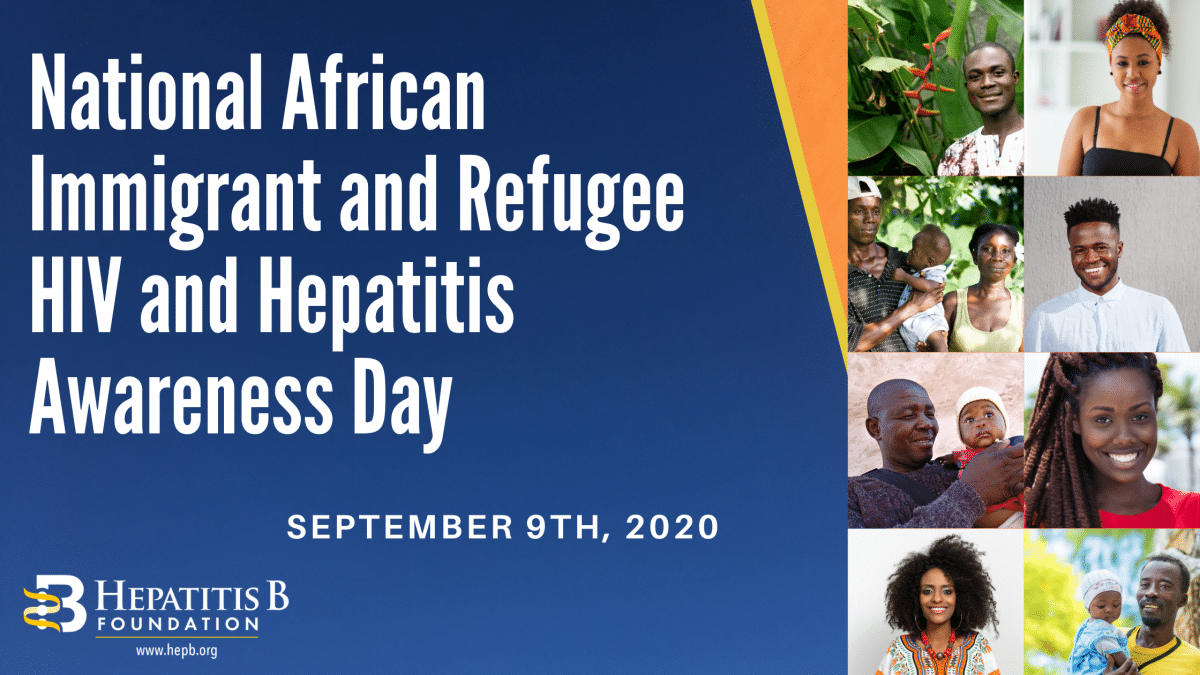
Commemorating National African Immigrant and Refugee HIV & Hepatitis Awareness (NAIRHHA) Day 2020
Each year in September, the Hepatitis B Foundation, along with partners around the U.S., recognizes National African Immigrant and Refugee HIV and Hepatitis Awareness (NAIRHHA) Day. Founded by advocates in Massachusetts, Washington D.C., and New York, NAIRHHA Day has been observed annually on September 9th by healthcare professionals, awareness campaigns, and other organizations since 2014. Although not yet nationally recognized, the Multicultural AIDS Coalition (MAC) and the Coalition Against Hepatitis for People of African Origin (CHIPO) are working to establish NAIRHHA day as its own federally designated awareness day. As explained by Chioma Nnaji, Director at the Multicultural AIDS Coalition’s Africans For Improved Access (AFIA) program, there is a great need to establish NAIRHHA day as its own day. “Several of the current awareness days are inclusive of African immigrant communities, but do not comprehensively address their unique social factors and cultural diversity, as well as divergent histories and experiences in the US.”
Why NAIRHHA Day?
People born outside of the U.S. often face different health challenges than those born in the country and face various barriers to accessing important healthcare services. African immigrants (AI) are disproportionately burdened by HIV and hepatitis B. Advocates for NAIRHHA Day recognized the need to address these health issues in the community and thought that a combined awareness day would be the most effective way to reach the largest number of people impacted.
Hepatitis B presents a significant public health burden for many African countries, and subsequent immigrant populations living in the United States. Although data is limited on hepatitis B infection among African immigrant (AI) and refugee communities in the U.S., studies have shown infection rates are high – between 5 and 18%1,2,3,4,5. One community study in Minnesota even found AIs accounting for 30% of chronic hepatitis B infections 6. AI communities are also known to be disproportionately affected by HIV/AIDS, with diagnosis rates six times higher than the general U.S. population7. Despite this alarming disparity, HIV and hepatitis B awareness, prioritization, and funding has remained limited for this population.
Two of the largest barriers to testing for HIV and hepatitis B among African immigrants are lack of awareness and stigma. Cultural and religious values shape the way people view illness, and there can be fears around testing and diagnosis of illness, and moral implications for why someone may feel they are at risk. While stigma about HIV/AIDS and hepatitis B often come from within one’s own community and culture, it is primarily driven by lack of awareness. Oftentimes, awareness is low in an individual’s home country because of limited hepatitis and HIV/AIDS education, resources, and healthcare infrastructure. When they arrive in the U.S., awareness remains low for similar reasons. Community health workers and physicians are vital stakeholders to raise community awareness in a culturally sensitive way to help identify current infections and prevent future ones through vaccination.
Commemorating NAIRHHA Day in 2020
Recognizing NAIRHHA Day is important to address the numerous barriers to prevention and treatment that African immigrants face. It was also founded to acknowledge the cultural and ethnic differences that influence how African-born individuals interact with their medical community and the concept of illness. The specific goals of this day of recognition include:
- Raising awareness about HIV/AIDS and viral hepatitis to eliminate stigma;
- Learning about ways to protect against HIV, viral hepatitis and other related diseases;
- Taking control by encouraging screenings and treatment, including viral hepatitis vaccination;
- Advocating for policies and practices that promote healthy African immigrant communities, families, and individuals.
This year, CHIPO, Multicultural AIDS Coalition, Hepatitis B Foundation and CHIPO-NYC, developed a suite of social media materials to improve awareness and create action around hepatitis B. This year’s campaign is focused on the incorporation of African proverbs into health messaging around ending stigma and increasing hepatitis B and HIV awareness, screening, prevention, and treatment. All graphics and an accompanying list of posts and tweets to go with each one can be found in a Google Drive folder here. We will be promoting the materials throughout the month of September, and we invite you to share them widely. Together, we can make a difference to address HIV and viral hepatitis among African immigrant communities!
References:
- Kowdley KV, Wang CC, Welch S, Roberts H, Brosgart CL. (2012). Prevalence of chronic hepatitis B among foreign-born persons living in the United States by country of origin. Hepatology, 56(2), 422-433. And Painter. 2011. The increasing burden of imported chronic hepatitis B—United States, 1974-2008. PLoS ONE 6(12): e27717.
- Chandrasekar, E., Song, S., Johnson, M., Harris, A. M., Kaufman, G. I., Freedman, D., et al. (2016). A novel strategy to increase identification of African-born people with chronic hepatitis B virus infection in the Chicago metropolitan area, 2012-2014. Preventing Chronic Disease, 13, E118.
- Edberg, M., Cleary, S., & Vyas, A. (2011). A trajectory model for understanding and assessing health disparities in Immigrant/Refugee communities. Journal of Immigrant and Minority Health, 13(3), 576-584.
- Kowdley, K. V., Wang, C. C., Welch, S., Roberts, H., & Brosgart, C. L. (2012). Prevalence of chronic hepatitis B among foreign‐born persons living in the united states by country of origin. Hepatology, 56(2), 422-433.
- Ugwu, C., Varkey, P., Bagniewski, S., & Lesnick, T. (2008). Sero-epidemiology of hepatitis B among new refugees to Minnesota. Journal of Immigrant and Minority Health, 10(5), 469-474.
- Kim WR, Benson JT, Therneau TM, Torgerson HA, Yawn BP, Melton LJ 3d. Changing epidemiology of hepatitis B in a U.S. community. Hepatology 2004;39(3):811–6.
- Blanas, D. A., Nichols, K., Bekele, M., Lugg, A., Kerani, R. P., & Horowitz, C. R. (2013). HIV/AIDS among African-born residents in the United States. Journal of immigrant and minority health, 15(4), 718–724.

